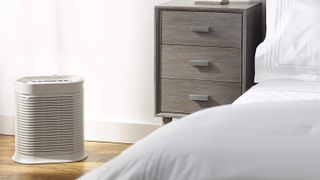How to ozone generators work?
Ozone generators produce electro-charged ozone that attaches to odor-causing microbes. Ozone is comprised of three oxygen atoms - the third can attach to molecules of other substances and therefore change their molecular structure, which can prevent them from giving off odors. Ozone generators penetrate carpets, walls, window treatments, light fixtures and air ducts with ozone, so it’s believed the gas will tackle hard-to-reach causes of odors. However, according to the EPA (opens in new tab), ozone generators are not as effective as some would have you believe. For example, “ozone generators are not effective in removing carbon monoxide”. Research has found that “some of the potential by-products produced by ozone’s reactions with other chemicals are themselves very reactive and capable of producing irritating and corrosive by-products”.
Ozone generators: Know the risks
Ozone is dangerous to breathe in large quantities. There are federal standards of how much ozone is safe to inhale, ranging between 0.05ppm and 0.10ppm. Some states, such as California, have even lower thresholds. Most ozone generators output ozone in quantities several times the recognized safety amounts. It usually takes up to 60 minutes after the generator cycle ends for the ozone to neutralize into oxygen that is safe to breathe. Breathing even minimal amounts of ozone can be toxic and according to the EPA, “if used at concentrations that do not exceed public health standards, ozone applied to indoor air does not effectively remove viruses, bacteria, mold, or other biological pollutants.” So basically, even if ozone generators can effectively kill odor, they will need to produce a very dangerous amount of ozone to do so. Lung irritation, ozone poisoning, lung scarring, cancer and death are all health risks associated with breathing ozone. In other words, buying an ozone generator is a really bad idea.
What can you use instead of ozone generators?
We’ve covered the topic of how to keep your indoor air pollution levels low (opens in new tab) extensively, and the Environmental Protection Agency has even reported that “a growing body of scientific evidence has indicated that the air within homes and other buildings can be more seriously polluted than the outdoor air in even the largest and most industrialized cities.” The best air purifiers (opens in new tab) are one option to clean dust, pollen and other particles from the air, but they’re less effective at removing odors. Respiratory issues can often be caused or exacerbated by poor indoor air quality, but odors and mold are often symptoms, and not causes, of this. Treating the symptoms of poor indoor air quality will only do half the work, because there’s no guarantee that odors will not return if the cause is left untreated. Mold, for example, is often caused by damp - so the best dehumidifiers (opens in new tab) are needed alongside the best mold test kits (opens in new tab) to eliminate the risk. Some of the best tower fans (opens in new tab) such as the Dyson Pure Cool Tower Fan (opens in new tab) have in-built air purifiers which can clean your indoor air and keep you cool at the same time. Another method to bring fresh air into your home is window air conditioners (opens in new tab) or central air conditioner (opens in new tab) units.
